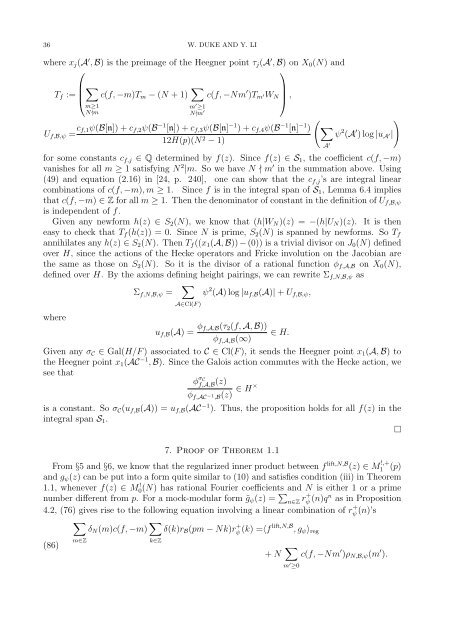Mock-modular forms of weight one - UCLA Department of Mathematics
Mock-modular forms of weight one - UCLA Department of Mathematics
Mock-modular forms of weight one - UCLA Department of Mathematics
You also want an ePaper? Increase the reach of your titles
YUMPU automatically turns print PDFs into web optimized ePapers that Google loves.
36 W. DUKE AND Y. LI<br />
where x j (A ′ , B) is the preimage <strong>of</strong> the Heegner point τ j (A ′ , B) on X 0 (N) and<br />
⎛<br />
⎞<br />
∑<br />
T f := ⎜<br />
⎝ c(f, −m)T m − (N + 1) ∑ c(f, −Nm ′ )T m ′W N<br />
⎟<br />
⎠ ,<br />
m≥1<br />
m ′ ≥1<br />
N∤m<br />
N∤m ′ (<br />
U f,B,ψ = c f,1ψ(B[n]) + c f,2 ψ(B −1 [n]) + c f,3 ψ(B[n] −1 ) + c f,4 ψ(B −1 [n] −1 ) ∑<br />
ψ 2 (A ′ ) log |u<br />
12H(p)(N 2 A ′|)<br />
− 1)<br />
A ′<br />
for some constants c f,j ∈ Q determined by f(z). Since f(z) ∈ S 1 , the coefficient c(f, −m)<br />
vanishes for all m ≥ 1 satisfying N 2 |m. So we have N ∤ m ′ in the summation above. Using<br />
(49) and equation (2.16) in [24, p. 240], <strong>one</strong> can show that the c f,j ’s are integral linear<br />
combinations <strong>of</strong> c(f, −m), m ≥ 1. Since f is in the integral span <strong>of</strong> S 1 , Lemma 6.4 implies<br />
that c(f, −m) ∈ Z for all m ≥ 1. Then the denominator <strong>of</strong> constant in the definition <strong>of</strong> U f,B,ψ<br />
is independent <strong>of</strong> f.<br />
Given any newform h(z) ∈ S 2 (N), we know that (h|W N )(z) = −(h|U N )(z). It is then<br />
easy to check that T f (h(z)) = 0. Since N is prime, S 2 (N) is spanned by new<strong>forms</strong>. So T f<br />
annihilates any h(z) ∈ S 2 (N). Then T f ((x 1 (A, B)) − (0)) is a trivial divisor on J 0 (N) defined<br />
over H, since the actions <strong>of</strong> the Hecke operators and Fricke involution on the Jacobian are<br />
the same as those on S 2 (N). So it is the divisor <strong>of</strong> a rational function φ f,A,B on X 0 (N),<br />
defined over H. By the axioms defining height pairings, we can rewrite Σ f,N,B,ψ as<br />
Σ f,N,B,ψ =<br />
∑<br />
ψ 2 (A) log |u f,B (A)| + U f,B,ψ ,<br />
where<br />
A∈Cl(F )<br />
u f,B (A) = φ f,A,B(τ 2 (f, A, B))<br />
∈ H.<br />
φ f,A,B (∞)<br />
Given any σ C ∈ Gal(H/F ) associated to C ∈ Cl(F ), it sends the Heegner point x 1 (A, B) to<br />
the Heegner point x 1 (AC −1 , B). Since the Galois action commutes with the Hecke action, we<br />
see that<br />
φ σ C<br />
f,A,B (z)<br />
φ f,AC −1 ,B(z) ∈ H×<br />
is a constant. So σ C (u f,B (A)) = u f,B (AC −1 ). Thus, the proposition holds for all f(z) in the<br />
integral span S 1 .<br />
□<br />
7. Pro<strong>of</strong> <strong>of</strong> Theorem 1.1<br />
From §5 and §6, we know that the regularized inner product between f lift,N,B (z) ∈ M !,+<br />
1 (p)<br />
and g ψ (z) can be put into a form quite similar to (10) and satisfies condition (iii) in Theorem<br />
1.1, whenever f(z) ∈ M 0(N) ! has rational Fourier coefficients and N is either 1 or a prime<br />
number different from p. For a mock-<strong>modular</strong> form ˜g ψ (z) = ∑ n∈Z r+ ψ (n)qn as in Proposition<br />
4.2, (76) gives rise to the following equation involving a linear combination <strong>of</strong> r + ψ (n)’s<br />
∑<br />
δ(k)r B (pm − Nk)r + ψ (k) =〈f lift,N,B , g ψ 〉 reg<br />
(86)<br />
m∈Z<br />
δ N (m)c(f, −m) ∑ k∈Z<br />
+ N ∑ m ′ ≥0<br />
c(f, −Nm ′ )ρ N,B,ψ (m ′ ).
















